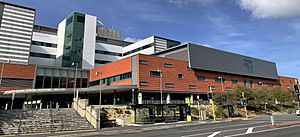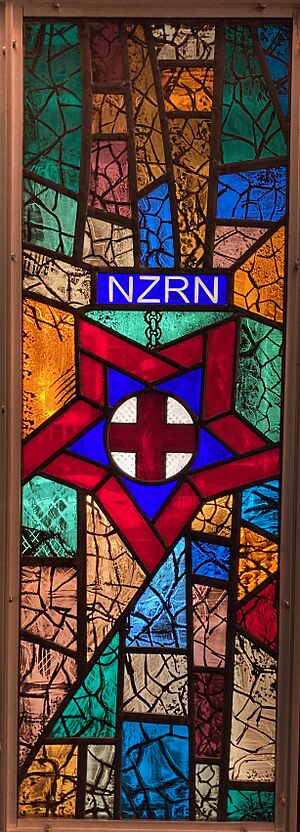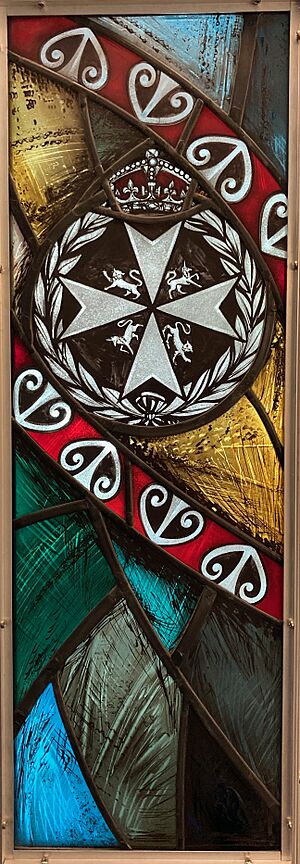Wellington Hospital, New Zealand facts for kids
Quick facts for kids Wellington Hospital |
|
|---|---|
| Te Whatu Ora | |

Wellington Regional Hospital main building in April 2020
|
|
| Geography | |
| Location | Newtown, Wellington, New Zealand |
| Organisation | |
| Funding | Public hospital |
| Services | |
| Emergency department | Yes |
| Helipad | (ICAO: NZWH) |
| History | |
| Founded | September 1847 |
Wellington Hospital, also known as Wellington Regional Hospital, is a major hospital in Wellington, New Zealand. It is located in the suburb of Newtown, just south of the city centre. This hospital is managed by Te Whatu Ora, Capital, Coast and Hutt Valley.
The hospital provides healthcare for people living in Wellington City, Porirua, and the Kāpiti Coast District. Nearby areas like Lower Hutt and Upper Hutt have their own hospital, Hutt Hospital.
Wellington Hospital is the main "tertiary hospital" for the Wellington Region. This means it offers very special and complex medical care. These services include the Intensive Care Unit, heart surgery, cancer treatment, and brain surgery. The hospital also helps patients from other parts of New Zealand. This includes the lower North Island and the top of the South Island.
The hospital works closely with the University of Otago, Wellington. The university's medical and health sciences campus is right next to the main hospital buildings.
Hospital Services
Main Hospital Building
Wellington Hospital has 484 beds for patients. It provides many different services. These include care for children, maternity services for new mothers, and various surgical and medical treatments.
Mental Health Services
There is a separate building on the hospital campus for mental health services. This facility has 29 beds and provides special care for people needing mental health support.
Te Wao Nui – Child Health Service
Te Wao Nui is the new children's hospital. It is located in the Mark Dunajtschik and Dorothy Spotswood Building. This building opened on September 30, 2022.
It has 50 beds for children who need to stay in the hospital. It also has clinics for children to visit during the day. A special bridge connects this building to the main hospital.
Emergency Department
The Emergency Department is where people go for urgent medical help. It is located on Riddiford Street. In 2023, plans were announced for a new, larger Emergency Department.
Hospital History
Early Years (1880s–1920)
The very first hospital in Wellington was built in 1847 in Thorndon. It was called the Colonial Hospital. A new hospital in Newtown, designed by Christian Toxward, started being built in 1876. It opened in 1881.
Between 1881 and 1912, the hospital grew a lot. Six new buildings were added. In 1901, the Victoria Operating Theatres opened. A home for nurses opened in 1904 and was made bigger in 1907.
In 1910, a special Fever Hospital opened to care for people with infectious diseases. A new children's hospital, the King Edward VII Memorial Hospital, opened in 1912. This hospital was decorated with 18 beautiful Royal Doulton tiles. These tiles showed different nursery rhyme scenes.
During World War I (1914-1918), the hospital was very busy. Many soldiers needed treatment. There were also staff shortages and the 1918 flu epidemic caused many people to need care.
Growing and Changing (1920s–1940s)
After World War I, the hospital added many new specialist departments. These included clinics for tuberculosis, cancer, and heart conditions. A new main administration building opened in 1927.
During the Great Depression in the 1930s, the hospital faced money problems. It was also very crowded. During World War II (1939-1945), more military patients arrived. A new building, called the 210 block, was finished in 1944. This helped with the overcrowding. The hospital celebrated its 100th birthday in 1947.
Modern Era (1950s–1970s)
From the 1950s to the 1970s, there were many plans to update the hospital. New medical areas like neurology and kidney dialysis needed space. The hospital also planned to include a school to train medical students.
New operating theatres and patient beds opened in the late 1950s. This allowed for more complex heart and chest surgeries. Two new homes for nurses also opened. In 1966, the 150-bed Seddon block opened. It was used for heart, kidney, and other medical patients.
Three more buildings opened in the 1970s. The Academic block, for the medical school, opened in 1977. The Clinical Services building opened in 1978. The Grace Neill block, named after nurse Grace Neill, also opened in 1978. It provided services for pregnancy and women's health.
Recent Developments (1980s–2000s)
More new buildings opened in the 1980s. Many older hospital buildings were taken down to make space. The old King Edward VII Memorial Hospital was demolished in 1988. A new children's hospital opened that year. The special nursery rhyme tiles from the old building were saved. They were put back up in 1992.
A new emergency department opened in 2000. In May 2002, a big project to redevelop the hospital began. This project focused on building a new main hospital building. It included a new Intensive Care Unit and operating theatres. Construction started in 2004. The new hospital was officially opened on March 6, 2009.
In September 2022, the new Mark Dunajtschik and Dorothy Spotswood Building opened. This building houses the child health services. Local property developers Mark Dunajtschik and Dorothy Spotswood gave $53 million towards building it. This building has special features to protect it during an earthquake. The main hospital building also has these earthquake protection features.
In May 2025, the New Zealand Government announced plans to add 126 more beds and treatment spaces at Wellington Hospital.
Nurses' Memorial Chapel
The Nurses' Memorial Chapel was a special place at the hospital. It was one of only three chapels in New Zealand built to remember nurses. Plans for the chapel started in 1933. Money was raised from many people and groups.
The chapel officially opened on October 30, 1965. A special part of the chapel was its beautiful stained-glass windows. These windows showed different scenes and symbols. They included images of saints, Florence Nightingale's lamp, and the New Zealand Registered Nurses badge. Many windows were dedicated to nurses who worked at the hospital.
The chapel was used for services and quiet reflection. Over time, fewer religious services were held. In 2000, it became a Nursing Education Centre. The chapel was taken down in 2004 to make way for new hospital buildings. The stained-glass windows were saved. Most of them were put back into the chapel in the new hospital building in 2010.
Notable Staff
- Eric Anson, anaesthetist
- Campbell Begg, doctor
- Agnes Bennett, one of the first women doctors
- Charles Burns, doctor
- Ellen Dougherty, nurse
- James Elliott, first house surgeon and later surgeon
- John Ewart, medical superintendent
- Truby King, medical superintendent
- Kate Marsden, matron
- Nina Muir, first woman house surgeon
- Grace Neill, nurse
- Daisy Platts-Mills, one of the first women doctors
See also




